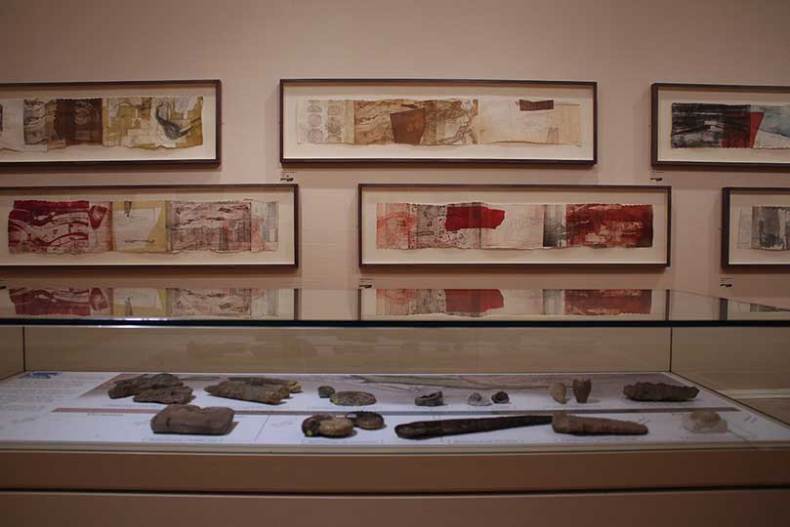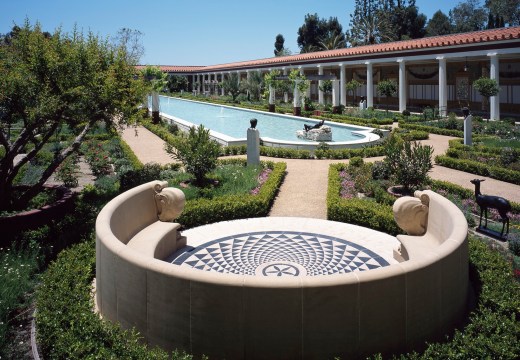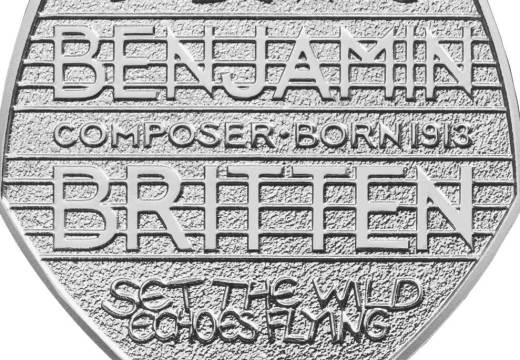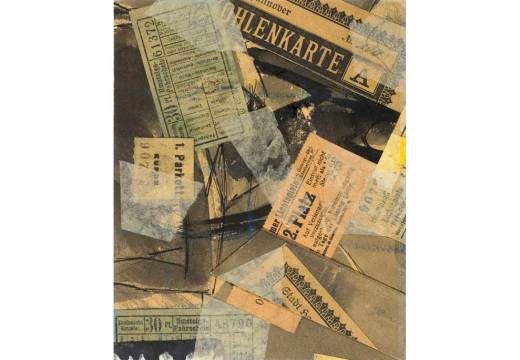‘Seaside surrealism’ was Paul Nash’s assessment of the uncanny coastline of Dorset, where he lived in the mid 1930s. Swans on the ocean, ammonites in the rock, driftwood gnarled into human form: everything seemed somehow out of place, resonant. Cliffs stacked up time in visible strata. A walk on the beach was a walk among objets trouvés.
Jeremy Gardiner isn’t exactly a surrealist, but his depictions of the Jurassic Coast share Nash’s delight in formal experiment, geometrical form, and the resonance of found objects. The 60-odd works on show at the Victoria Art Gallery in Bath range in date from 1996 to 2014 – in a way, the exhibition itself constitutes the kind of geological slice of time that so many of Gardiner’s works resemble – and display a remarkable consistency of vision. Two main forms are on display, as well as a couple of small etchings.

Arish Mell, March (monoprint), Jeremy Gardiner
First of all there are textured paintings built up out of acrylic and Jesmonite in sculptural waves and ridges, on shaped wooden panels eroded like driftwood or on paper torn into ragged cliff edges. Some of these are built into undulating reliefs, with casts of fossils shaping the surface of the work; others are sharper-edged, shelving off into angles that accentuate the geometrical abstraction of the visible landscape. Recognisable features of the Dorset coast – Old Harry Rocks, Gad Cliff, Ballard Point – are compressed into fields of view that break apart and come together in several perspectival planes. There is also a series of long monoprints, some vertical, some horizontal, swept over by contour lines and fossil shapes or coloured to resemble visualised layers of deep time. These prints have a more diagrammatic feel to them than the paintings; they draw less on the tradition of abstract landscape painting than on the visual registers of cartography, geology, and palaeontology.
The most striking of these works are the ones that resist the temptation to represent, that refuse to be too literal about the littoral. From the fossil record, Gardiner draws marvellous patterns and textures and integrates them, often subtly, into multiple layers of colour and form. It’s more difficult to see what is added by the inclusion (in the monoprints) of fully-rendered fossil organisms or (in the paintings) of whole ammonites cast in relief. The latter do, of course, connect the work to natural processes of casting and moulding that occur in fossilization, bringing the effects of time and place into the work itself. The exhibition even includes a set of fossils provided by the Bath Royal Literary and Scientific Institution so that visitors can make their own comparisons.

Installation view, ‘Jeremy Gardiner: Jurassic Coast’, Victoria Art Gallery, Bath, January 2015
For me, these instantly-recognisable forms draw the eye a little too insistently away from the brilliantly rearticulated spatial relationships of the landscapes; when they appear, their straightforwardly diagrammatic form can sometimes throw off the balance between representation and abstraction that the best of these pieces scrupulously maintain. Yet taken as a whole, these paintings and prints of deep time manage to renew a well-known landscape in subtle and unexpected ways. There is a large amount of high-quality work to be seen here, the result of a 20-year collaboration between an innovative artist and a singular place.
‘Jeremy Gardiner: Jurassic Coast’ is at the Victoria Art Gallery, Bath, until 1 March.
Related Articles:
New Horizons: British art and flight (Maggie Gray)
‘Another Life, Another World’: Paul Nash’s watercolours (Maggie Gray)
Unlimited access from just $16 every 3 months
Subscribe to get unlimited and exclusive access to the top art stories, interviews and exhibition reviews.














![Masterpiece [Re]discovery 2022. Photo: Ben Fisher Photography, courtesy of Masterpiece London](http://www.apollo-magazine.com/wp-content/uploads/2022/07/MPL2022_4263.jpg)
It’s time for the government of London to return to its rightful home